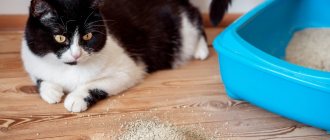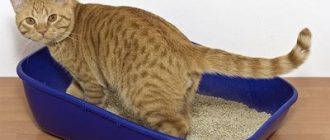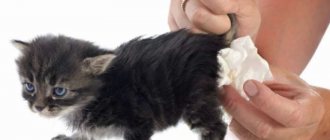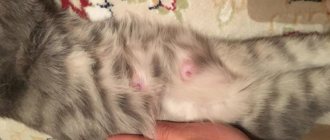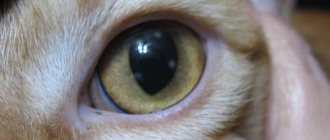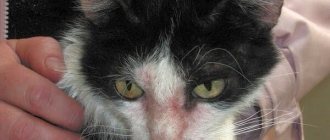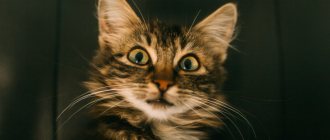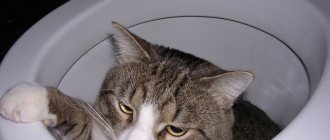Diagnostics
If there is a lot of blood or it appears in the stool not for the first time, then you should immediately show the kitten to the veterinarian.
This is especially important if the pet looks sick, has difficulty defecating, has difficulty passing feces, has vomiting, loose stools
The veterinarian will take blood, feces and urine for analysis, carefully examine the rectum and pet, and ask you to talk about the animal’s diet and care measures, and changes in behavior. Based on the results of the examination, medications will be prescribed. Feces taken by the owner of the animal will quickly allow you to make an accurate diagnosis. In the vast majority of cases, the treatment of ailments associated with blood in the feces of kittens is simple and the baby will be healthy within a few days.
shutterstock
Treatment for black stools
Treatment methods and the use of medications depend on the diagnosis. In general, treatment is carried out as follows:
- Stop bleeding. This is the first priority. Losing a large amount of blood can be fatal. Purr is prescribed hemostatic drugs: “Vikasol”, “Ditsinon”. It is important to follow the dosage prescribed by your doctor, otherwise the risk of blood vessel blockage with blood clots increases.
- Elimination of the cause of the pathology. If a cyst or foreign body is detected in the gastrointestinal tract, surgical intervention is prescribed.
- Deworming. Even if the cause of the bleeding was not parasites, but the infection was discovered through tests, the cat must be given anthelmintic drugs.
- Antibacterial therapy. The purr is prescribed antibiotics, antiviral drugs and immunomodulators if the cause of the pathology is an infectious disease.
- Elimination of ulcers. When ulcers are detected, gastroprotectors are used, for example, Almagel, Phosphalugel.
Table: Effective treatment methods
Therapy will be effective only after identifying the cause of the change in stool. Attempting to treat your pet on your own without medical advice is dangerous for the animal’s life.
Depending on the cause and condition of the cat, he may be prescribed IVs to replenish lost fluid and vitamin injections. However, treatment cannot begin until the bleeding has stopped.
Black stool is not a separate disease, but a symptom of a large number of pathologies, but most often the cause is internal bleeding. In order to provide timely assistance to your pet, you should be attentive to cleaning the litter box, studying the cat's stool, its color, consistency, and the presence of parasite particles in it. Don't panic if your pet's behavior doesn't change.
Recommended Posts
What to do if your cat has blood in the stool: causes, diagnosis and treatment
Causes and treatment options for diarrhea in cats
What to do if your cat has a big belly: causes, treatment and prevention
A cat scratches its neck: possible causes of itching and methods of treatment
Common ear sores in cats: symptoms and treatment methods
Causes of white feces in dogs and other abnormalities
Black feces in cats
All food that a domestic cat eats undergoes a specific treatment with gastric juice, after which a mushy mass - chyme - enters the intestines. Normally, chyme moves through the small intestine for 8 hours, and once it enters the large intestine, it begins to form feces.
Under normal circumstances, a cat should sit on the litter box about 1-2 times a day. The discharge should be well formed, moist and soft, but not loose. The color of the feces ranges from light to dark brown, again depending on the food consumed. They should not contain any impurities (mucus, blood or particles of undigested food). But if the stool becomes liquid or changes color, you need to be concerned.
Causes of bowel dysfunction
Regarding toxic poisoning, they do not occur often in animals, because the cat is considered a very finicky animal in terms of nutrition, and he will not eat anything he gets. But such situations are still not excluded, because cats are clean and by licking their fur, he can swallow particles of chemicals that are on it.
Kitten has diarrhea
In order for your cat to grow healthy and always remain cheerful, you need to provide him with proper nutrition. But every owner wants to pamper his pet with some yummy food, without the thought that this may lead to the development of a digestive tract disorder.
Black feces in cats
In such a case, immediate consultation with a veterinarian is necessary, since the presence of internal bleeding can lead to death due to massive blood loss.
If there are serious pathological conditions in the cat’s body, in addition to black stool, it may develop symptoms in the form of black or red vomit, bleeding from the anus, general malaise due to constant blood loss, nausea, and acute pain in the abdominal cavity. It is necessary to take into account the fact that black discharge is feces with admixtures of coagulated blood, which means the reason lies in problems with the upper gastrointestinal tract. Red stool, on the contrary, indicates problems in the lower gastrointestinal tract, because more fresh blood is released in the feces.
Sometimes, black stools may alternate with red ones. This happens when the color of the blood changes, which has interacted with digestive enzymes.
Typical causes of black stool
If your cat's stool contains blood, you should seek help from a veterinarian as soon as possible. This is a frequent signal of the presence of severe gastrointestinal pathology, which can lead to the most unpredictable consequences, including death.
Foreign objects often enter the intestines, especially if the animal has been playing around with objects that are not suitable for play. A kitten or an adult cat can swallow a piece of fabric, sharp objects and anything that can damage their gastrointestinal tract.
The presence of an atypical color of discharge may indicate helminthic infestation. But with this disease, in addition to blood in the stool, the cat will experience nausea, vomiting, diarrhea, weakness and lack of appetite. If the parasites lead to serious complications, then treatment should only be carried out by an experienced specialist who will prescribe the appropriate medications and their exact doses.
If the owner notices black discharge from his pet, he should not hesitate and self-medicate. Only an experienced veterinarian will be able to establish a diagnosis and prescribe treatment that will help rid the cat of an unpleasant illness.
Very often, a similar condition is observed in animals that were picked up on the street, and in cats that spend most of their time on the street, which means they are in contact with other animals (including stray ones).
What to feed a cat during diarrhea
Note that in the first day after the onset of diarrhea, the pet should be put on a starvation diet, without restricting water. Such a “fast” is needed so that during the rest period the animal’s digestive system returns to normal.
But still, what should you feed your pet so as not to burden its gastrointestinal tract, but at the same time not starve it? Even among experienced veterinarians and breeders there are many opinions on this matter, but the “average optimal value” can be deduced from their recommendations:
Boiled rice. It is best to use round varieties, boiling the product to a semi-liquid pulp. This consistency has a positive effect on the condition of the long-suffering intestinal mucosa without further irritating it. The pet should be fed this for the first day or two.
Chicken bouillon. The better the cat becomes, the more saturated broths can be used. We warn you once again that at first it is extremely undesirable to use fatty foods, as they will almost certainly cause a violent relapse of diarrhea.
Boiled chicken. It is advisable to use the breast as the least fatty part. It is necessary to constantly monitor the cat’s well-being and, if signs of stool liquefaction appear, reduce the amount of meat in its food.
High-quality low-fat by-products
But this must be done as carefully as possible, starting from the first week after the last attack of diarrhea.
Finally, to relieve bouts of diarrhea, you can use pumpkin puree from baby food. The dose is approximately half a teaspoon at a time. The duration of submission is approximately three days.
What might the stool of a sick animal look like?
In the tray of his pet, the owner may find feces that differ in shape:
- ointment-like;
- mushy;
- liquid;
- foamy;
- in the form of “goat peas”;
- in the form of a tape or pencil.
By smell they distinguish: sour, rancid, putrefactive.
- Feces acquire a sour smell when the absorption of fatty acids in the small intestine is disrupted or due to fermentation processes in the large intestine.
- An unpleasant odor, similar to the smell of bad oil, occurs when the secretory function of the pancreas is disrupted or when the flow of bile is disrupted.
- The smell of rotting occurs when digestion in the stomach is disrupted, dyspepsia develops with the proliferation of putrefactive microflora in the intestines. Or the cat suffers from colitis with ulcerations.
It is customary to distinguish feces by color:
- red (beetroot);
- black (tarry);
- dark brown;
- light brown;
- with a scarlet admixture (undigested blood);
- yellow;
- light yellow;
- greenish yellow;
- bleached slightly yellow, gray, gray-white.
A healthy cat can have red or beetroot feces if it has eaten beets or food colored with bright dyes. This coloring is not pathological and soon the stool acquires a normal color.
Reasons for changes in stool
Changes in the color and consistency of feces in a kitten or adult cat are often associated with errors in nutrition. When eating unsuitable food, the load on the digestive organs increases. The stomach does not completely digest food, and the intestines cannot fully absorb it. The result is unformed feces in which mucous particles can be found.
Other common causes
Intestinal dysfunction can lead to a change in the color of stool, as a result of which food stagnates in the intestines.
But in addition to poor-quality food, the following diseases and disorders can affect the consistency of excrement:
- Intestinal dysfunction. Insufficient secretion of digestive juices and weak peristalsis contribute to stagnation and fermentation of eaten food in the body. Soon, pathogenic microflora begins to actively multiply, causing increased gas formation and flatulence. The cat's feces turn out to be green.
- Insufficient enzymatic activity of the pancreas. The consequence of this disorder is poor digestion of food, resulting in yellow feces remaining in the tray.
- Hepatitis. As the disease progresses, the functioning of not only the liver, but also the gallbladder is disrupted. As a result, the cat's feces become discolored, but the urine becomes dark brown.
- Internal hemorrhage. If the cat passed liquid black feces onto the tray, this means that bleeding has occurred in the stomach, or more precisely, in the upper section. When bright red blood is present in the stool, this indicates that damage has occurred in the intestine itself.
Orange dry feces often appear in pets when they eat food colored with dyes. If the stool is not soft, but hard, like a goat's, this means that the animal's diet does not have enough fluid. In this case, it is enough to adjust the menu and change the brand of food. If, even after changing the diet, the cat poops liquid or too dry, it is better not to hesitate to visit the veterinarian.
Bacteria
If your cat eats something contaminated with bacteria such as E. coli or salmonella, it can cause foul-smelling feces, as well as stomach upset, inflammation and diarrhea. Some cats love to hunt for food (even if they don't have to!), and eating rodents or birds can put them at risk of bacterial infection.
- Solution : If your cat's smelly feces do not improve after 48 hours, seek advice from your veterinarian.
Symptoms
If there are serious pathological conditions in the cat’s body, in addition to black stool, it may develop symptoms in the form of black or red vomit, bleeding from the anus, general malaise due to constant blood loss, nausea, and acute pain in the abdominal cavity. It is necessary to take into account the fact that black discharge is feces with admixtures of coagulated blood, which means the reason lies in problems with the upper gastrointestinal tract. Red stool, on the contrary, indicates problems in the lower gastrointestinal tract, because more fresh blood is released in the feces.
Sometimes, black stools may alternate with red ones. This happens when the color of the blood changes, which has interacted with digestive enzymes.
The cat walks outside the litter box
Even if your cat's poop doesn't smell any worse than usual, if you don't cover it with a litter box, it will start to smell bad. This could be a sign that the litter is hurting your cat's paws or that she doesn't like the texture or smell of the litter. Cats that poop outside the litter box may have trouble accessing a litter box that has high sides or may have a litter box that is too small.
- Solution : Try switching to a different brand of litter, or offering your cat a lower-sided or much larger litter box. Ask your veterinarian to check if your cat is sick. Cats who are stressed due to a recent change in circumstances may also poop outside the litter box.
What to do for prevention?
Preventive measures involve systematic treatment for worms. Liquid or dry feces that are constantly observed in a pet are, in any case, evidence of some kind of internal progressive disorder
To prevent consequences dangerous to the cat’s health and life, it is important to follow preventive rules. First of all, it is important to monitor the cat’s diet and provide it with fresh and clean water.
Do not forget to carry out preventive anthelmintic treatment.
If viral infectious diseases develop, do not self-medicate, but take the animal to a veterinarian, who, based on the diagnostic results, will select an effective treatment. In order for the cat’s body to more actively resist various diseases, it is useful to strengthen the pet’s immunity. To do this, it is recommended to give courses of vitamins and various biologically active supplements, which are selected by the veterinarian, taking into account the individual characteristics of the cat.
Features of treatment
Dry feces often cause severe constipation, which causes discomfort and discomfort to the cat. In order to eliminate this symptom, you should first consider your pet’s diet.
Remember some important nutritional tips:
- You cannot feed your pet only meat or fish; you should definitely include porridge in the menu. Fiber causes a laxative effect and speeds up the movement of food through the intestinal area;
- porridge can be mixed with vegetables - cauliflower, carrots, broccoli;
- pureed meat or canned food must be mixed with steamed bran;
- Dry feces often occur due to insufficient water intake, especially if dry food predominates on the menu. In these cases, the cat, even with free access to water, does not drink 30% of its daily requirement. It is better to include mixtures in the form of pates and jellies that contain moisture.
Nutrition
Let's start with the last reason. A question that Murok and Barsikov owners often ask is whether cats can have raw meat? They can do anything, but their usefulness is in question. Cats and cats are allowed to eat raw meat in small quantities. Just before you treat your pet to something tasty, you need to defrost and scald the product with boiling water.
The reasons for black feces in cats lie in overeating meat. When the pet has enjoyed a hearty meal the day before, the owner will receive a surprise in the morning. In this case, panic is not appropriate, because there is nothing terrible. A completely normal reaction of the body to “overeating” raw meat.
By the way, if the animal takes any nutritional supplements containing iron, then black feces are completely normal. The same can be said for foods high in iron.
Diarrhea symptoms
If the color of the bowel movements deviates from the norm, and your pet is losing a lot of hair, you should consult a specialist.
Cat feces that differ from the norm in color and consistency are already a pathological sign, indicating that not everything is in order with the pet’s body. Other symptoms that require immediate action:
- violation of general condition;
- nausea accompanied by vomiting;
- weakness, drowsiness, apathy;
- increased gas formation;
- persistent constipation or, conversely, diarrhea;
- increased body temperature;
- abdominal pain on palpation;
- blanching or yellowing of the mucous membrane;
- dullness and excessive hair loss;
- lack of appetite;
- rapid weight loss.
Regardless of the etiology (i.e. origin) of diarrhea, all its types can be divided into two large types:
- Acute diarrhea.
- Chronic diarrhea.
Accordingly, the symptoms of these two varieties will differ significantly.
In this case, everything is quite simple and clear. First, you need to decide on the terminology: “acute” diarrhea is called in cases where it began suddenly and lasts no more than two days, accompanied by a significant deterioration in the condition of the sick animal.
The following signs of such diarrhea are distinguished:
Defecation is frequent, the animal constantly runs to the tray.
As a rule, feces are liquid; they often contain impurities in the form of mucus, half-digested pieces of food, and sometimes blood can be seen.
After just five or six trips to the potty, the animal begins to meow hoarsely, constantly licking the anus area.
If diarrhea continues for more than two days, the cat becomes noticeably weaker. In the most severe cases, the pet practically stops grooming itself, its fur becomes matted and becomes covered with a crust of dried feces.
In the same cases, severe blanching of all visible mucous membranes is observed. They become dry and sticky to the touch. The skin loses its elasticity, the coat becomes rough and hard.
The following conclusions can be drawn from all of the above:
If diarrhea lasts less than a day, and the general condition of the animal at this time remains stable and does not cause alarm, you can try to cope with diarrhea on your own.
In cases where a cat suffers from diarrhea for more than a day, and its condition is slowly but deteriorating, you should definitely show the animal to a veterinarian
This precaution will probably not be superfluous.
This type of pathology manifests itself somewhat differently:
Diarrhea occurs sporadically, not every day.
Interestingly, cases of diarrhea may well alternate with periods of “impenetrable” constipation.
The cat’s condition “by eye” remains normal, but this impression is wrong. If nothing is done and the true root cause is not identified, the animal will gradually develop exhaustion.
What can black feces mean in cats?
Black feces indicate that excess iron has entered the intestines. Most often, the anomaly occurs due to bleeding in the front of the digestive tract. Even short-term blackening, if it occurs frequently, can cause chronic diseases that destroy the health of the pet.
Diets based on raw meat, as a rule, contain excess protein and lack of dietary fiber, and therefore cause chronic diseases of the digestive system.
Brown-black cat feces with an unpleasant odor
In case of ulcerative pathologies or diseases of the pancreas, the animal’s own enzymes are not active enough. A significant portion of the nutrients remains undigested. It enters the large intestine, where it becomes prey for putrefactive microbes. Feces acquire an unpleasant odor, which is characteristic of rotting meat or rancid oil.
Be sure to read: The cat has dark urine: causes and treatment, what should be normal, what the color change indicates
Black feces are detected and the animal does not eat anything
A very bad sign. It is characteristic of panleukopenia, a disease of young animals accompanied by severe dehydration. The animal stops eating in a pre-agonal state. Feces may darken due to either bleeding or pre-mortem changes. The pet needs urgent veterinary care.
What if your cat has black, liquid stool and vomits?
A combination of black diarrhea, vomiting, refusal to feed, and a depressed state are signs of high infestation. Before deworming, it is necessary to stop the bleeding. Parasite control must be carried out under the supervision of a veterinarian.
Even with the correct dosage, intoxication cannot be ruled out, because before death, helminths release an increased amount of toxic decay products.
During autumn deratization, many mice poisoned with anticoagulants appear. They are easy prey. The poison affects cats even more strongly than rodents. Vomiting, black feces, depression and severe dehydration appear. If immediate help is not given, the cat will die.
When a visit to the vet should not be postponed
Urgent veterinary care is needed for your pet when the following additional symptoms occur:
- stomach ache;
- plaintive meow;
- temperature above 40 °C;
- diarrhea;
- vomit;
- refusal to eat;
- blood clots in excrement.
The most dangerous sign is the appearance of melena - feces with a tarry consistency, indicating large-scale bleeding.
Bristol scale
English doctors at the Royal Hospital in Bristol have developed a simple but unique scale that characterizes all the main types of feces. Its creation was the result of the fact that experts were faced with the problem that people are reluctant to open up about this topic; embarrassment prevents them from talking in detail about their stool.
Based on the developed drawings, it became very easy to independently characterize your own bowel movements without any embarrassment or awkwardness. Currently, the Bristol Stool Shape Scale is used throughout the world to assess the functioning of the digestive system. For many, printing a table (types of feces) on the wall in your own toilet is nothing more than a way to monitor your health.
1st type. Sheep feces
It is called so because it is shaped like hard balls and resembles sheep feces. If for animals this is a normal result of intestinal function, then for humans such stool is an alarm signal. Sheep pellets are a sign of constipation and dysbacteriosis. Hard feces can cause hemorrhoids, damage to the anus, and even lead to intoxication of the body.
2nd type. Thick sausage
3rd type. Sausage with cracks
Very often people consider such stools to be normal, because they pass easily. But make no mistake. Hard sausage is also a sign of constipation. When defecating, you have to strain, which means there is a possibility of anal fissures. In this case, irritable bowel syndrome may be present.
4th type. Ideal chair
5th type. Soft balls
This type is even better than the previous one. A few soft pieces form and come out gently. Usually occurs with a large meal. Stool several times a day.
6th type. Unshaped chair
The feces come out in pieces, but unformed, with torn edges. It comes out easily without hurting the anus. This is not diarrhea yet, but it is already a condition close to it. The causes of this type of stool can be laxative medications, increased blood pressure, excessive consumption of spices, and mineral water.
7th type. Loose stools
Digestive problems
If your cat's digestive system is unable to digest or absorb the fats and starches in its food, this can result in particularly smelly feces. The technical terms for these digestive problems are improper digestion and improper absorption.
- Solution : Your veterinarian will need to run tests to determine whether your cat is suffering from poor digestion or malabsorption, and will advise you on how to treat each accordingly.
How to accurately diagnose the disease
Only a veterinarian can identify the exact reason why a cat is bleeding profusely. The animal owner’s task is to help the specialist collect anamnesis. During the consultation you will have to answer the following questions:
- what does a pet eat?
- does he go outside?
- whether there are poisonous plants or other substances hazardous to health in the house that the cat could reach.
The veterinarian will ask how often your pet poops with blood in it and if there are any other warning signs. For example, constipation, diarrhea, poor appetite, depression. During the examination, the cat's temperature is taken.
To establish the exact cause of blood in the stool, additional research will be needed:
- analysis of stool, urine and blood (general, allergen and biochemical);
- Ultrasound of internal organs;
- X-ray of the intestine;
- colonoscopy;
- If tumors are detected, a biopsy will have to be done.
